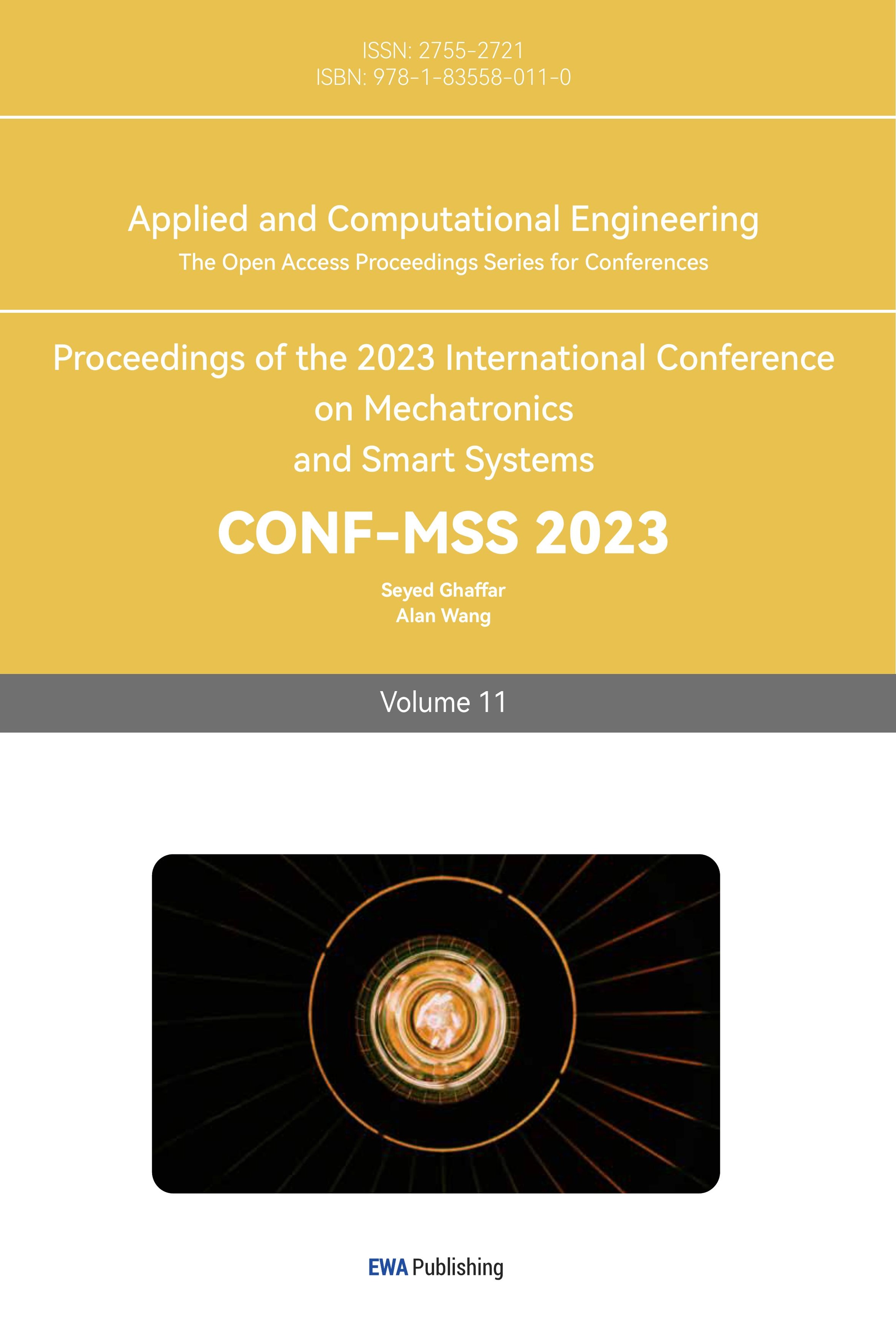1. Introduction
In a turbofan engine, the turbine extracts power to drive the compressor and the fan. The hot combustion gases are accelerated through nozzles to produce pure jet thrust like a turbojet engine. The fan speeds up the air passage, known as bypass air, by performing mechanical work directly on the air without appreciable heating of the bypass air. In this way, a turbofan combines the high-speed capacity of a pure turbojet engine with the energy efficiency and better acceleration features of a propeller. As a result, the majority of modern commercial line engines are turbofans.[1].
The difference in the type of engines is distinguished by the bypass utilized. Turbofan engines have a concept called bypass ratio, which describes the relationship between the mass flow through the blower, and the mass flows through the core. The formulation is expressed as follows:
\( β=\frac{\dot{m}fan}{\dot{m}core} \) (1)
An engine with a high bypass ratio is considered to be β greater than 4 or 5. The diameter of the fan is larger as well. Currently, the newest turbofan engine, such as GE9X, has β as high as 10, with a diameter of 340 mm.
2. Development
After the end of World War II, a large number of military transport aircraft retired from active service, and a large number of qualified military pilots were also looking for jobs. Due to these abundant resources, a large number of private airlines emerged. A variety of military transport aircraft was converted into passenger planes. However, the surplus of Douglas C-47 and De Havilland's "Dragon Rapides" quickly became old and obsolete. New commercial aircraft were desperately needed to replace them. While some airlines have paid attention to larger and more sophisticated new piston commercial aircraft, Lockheed "Constellation" and Boeing "Stratocruiser", a few forward-looking manufacturers have realized that the future of commercial aircraft belonged to jetliners.
In October 1945, a "Lancaster City" transport aircraft VH742 from the former British Air Force was handed over to Rolls-Royce for modification. Two "Merlin V-12" piston engines on the outside of the aircraft's wings were removed and replaced with two Rolls-Royce "Nene" turbojet engines which were applied on De Havilland "Comet" military fighters later on. However, this "Lancaster City" retained the "Merlin" piston engine, essentially a turbojet engine experiment table.
2.1. Nene1
On April 6, 1948, the world's first jetliner, the "Nene Viking" (G-AJPH), had its first flight, which Vickers-Marlin Company produced. This "Viking" (G-AJPH) was modified at Vickers' Wesley plant. Two Bristol "Hercules" piston engines were replaced by "Nene I" turbojet engines which produced 22.2 kN of thrust.
"Nene Viking" could fly up to 741 km/h but usually cruised at 630 km/h. It could also climb up to an altitude of 3,000 meters in just 3 minutes, with an absolute ceiling of 13,400 meters, 6,000 meters higher than its piston counterpart.
2.2. JT3C/D
On July 15, 1954, Boeing 367-80 made its first flight. Boeing 707, which first flew on December 20, 1957, was an improved version of Boeing 367-80. The four turbojet engines from Boeing 707 were installed in nacelles under wings, making engine maintenance easier. Boeing 707 retained Pratt & Whitney JT3C turbojet engine nacelles on the 367-80 borrowed from the Boeing B-47 jet bomber. Accordingly, it was designed to have a larger fuselage cross-sectional area. In the later version of Boeing 707, JT3C engines were replaced by JT3D.
The JT3C engine has the maximum thrust increases to 53.5 kN, which was 1.5 times higher than the "Nene 1" engine, with a low bypass ratio of 1.42:1 [2]. During this time, all jetliners were narrow-body aircraft with a small passenger capacity and still used turbojet engines with a very low bypass ratio. The wide-body jetliner did not come out until 1968.
2.3. JT9D & RB211-524
On September 30, 1968, the first 747 was deployed at the Everett factory. It came into operation at Pan Am on January 22, 1970. Boeing 747 was the first wide-body jetliner and the first one that applied high bypass ratio turbofan engines. Initially, the Boeing 747 was powered by JT9D, followed by General Electric CF6 and Rolls-Royce RB211 for the later version. [3].
Due to the introduction of the concept of a high bypass ratio, engines have undergone rapid development. Contrasted with previous low-bypass turbojet engines, high bypass provided greater thrust, better fuel economy, and a lower degree of noise, producing a greater economic effect. In the series of RB211-524, which was used by 747, the maximum thrust had already increased to 253.0-264.4 kN, with a bypass ratio of 4.3:1 to 5:1 [4]. Contrasted with JT3D in the 1950s, the maximum thrust increased 5 times, and the bypass ratio increased 3 to 4 times. Such improvement vastly increased the efficiency of jet engines in an airliner, allowing airliners to carry long distances of airline higher passenger capacity and much better economic effect.
Qantas's adoption of RB211-524 power underscores the significance airlines place on fuel economy for its new Boeing 747 aircraft, the only commercial aircraft on which all three large fans are usable. Boeing 747 from British Airways applied with RB211, which burns around 7% less fuel than the JT9D-equipped fleet and is estimated to save around $1 million per year per airliner at current prices [5].
2.4. GE9X
GE9X is a high bypass turbofan engine specially designed by Electric General for the latest generation of wide-body airliner 777X. It had its first flight test in April 2016. GE9X is an improved turbofan engine derived from the GE90 model. It is designed to improve fuel efficiency by 10%, contrasted with GE90. Most improvement related to the efficiency is originally from better propulsion efficiency for fans with a higher indicator of bypass ratio. The main fan in the front of the engine is installed in a 3.4m diameter enclosure. Contrasted with the 22 blades used in GE90 and 18 in GEnx, the fan used in GE9X has 16 blades. The change makes the motor lighter, enabling the low-pressure fan and supercharged compressor to run faster and better to reach their velocity to the low-pressure turbine. A leading steel edge manufactures the fan blades, and a fiberglass trailing edge, which has better flexibility than fiber made from carbon, confronts the emergency better, namely absorbing the striking of birds. The fourth-generation fiber composites made from carbon that make up the fan blades' body make them lighter, thinner, and more efficient. Using a composite fan case also saves weight [6].
2.5. Contrast
The following graphs record the main indexes of the above engines. JT3C, RB211-524H, and GE9X are recorded in Table 1 and Figures 1-4.
Table 1. Four indicators of JT3C, RB211-524H, and GE9X.
JT3C | RB211-524H | GE9X | |
Maximum thrust (kN) | 53.5 | 264.4 | 490 |
Bypass Ratio | 1.42:1 | 5.1:1 | 9.9:1 |
Overall Pressure | 12.5 | 32.9 | 61 |
Diameter (m) | 0.9906 | 2.19 | 3.40 |
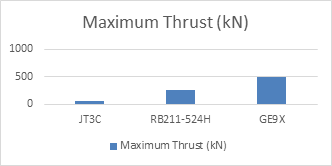
Figure 1. Indicators of maximum thrust.
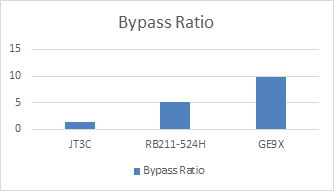
Figure 2. Indicators of bypass ratio.
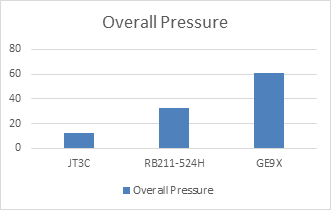
Figure 3. Indicators of overall pressure.
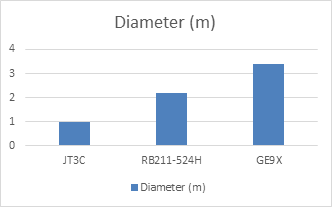
Figure 4. Indicators of fan diameter.
It can be seen from the above data comparison charts that the various indicators of jetliner engines have developed rapidly in the past few decades, especially after applying the concept of a high bypass ratio. Compared with the first-generation low-bypass turbojet engine JT3C, the above-mentioned indicators of the two high bypass ratio turbofan engines have almost been improved exponentially. Correspondingly, the engine's fuel efficiency and economic effect have been improved.
Compared to the turbojet engine and the turbofan engine, the major difference is that, for the turbofan engine, the forward compressor has a bigger diameter than the core behind, while the turbojet engine does not have the difference. [7].
Although low-bypass turbojet engines with smaller cross-sectional areas have lower air resistance and high-speed performance at high altitudes and high speeds, most airliners' cruising speed and altitude have not reached the advantage range of low bypass ratio turbojet engines, compared with military fighters. A high bypass ratio engine performs much better in low-speed conditions than a low bypass ratio engine. Formula used:
\( Thrust=gas mass flow×(jet speed-flight speed \) ) (2)
\( Εκ=\frac{1}{2}×m{v^{2}} \) (3)
The speed of a high bypass ratio engine that throws more air backward is lower than the low bypass ratio. Bigger reaction mass with lower speed carries away less energy for the same momentum. This energy has to be provided by the engine because the heating value of fuel is constant. An engine that requires less energy requires less amount of fuel accordingly. This is achieved by moving more air into the engine, contributing to a higher bypass ratio.
3. Advancement
3.1. General efficiency
Over the last 70 years, the thermodynamic efficiency of commercial aircraft engines has improved considerably from approximately 30% to over 50%, as shown in Figure 5 and Figure 6. The appearance of a high bypass ratio flourished during the development of the jet engine. Considering the airliner safety, weight, reliability and cost, currently, there were no clear figures about the maximum efficiency. However, with new materials and new structures of engines, increasing general efficiency by about 30% is still achievable.
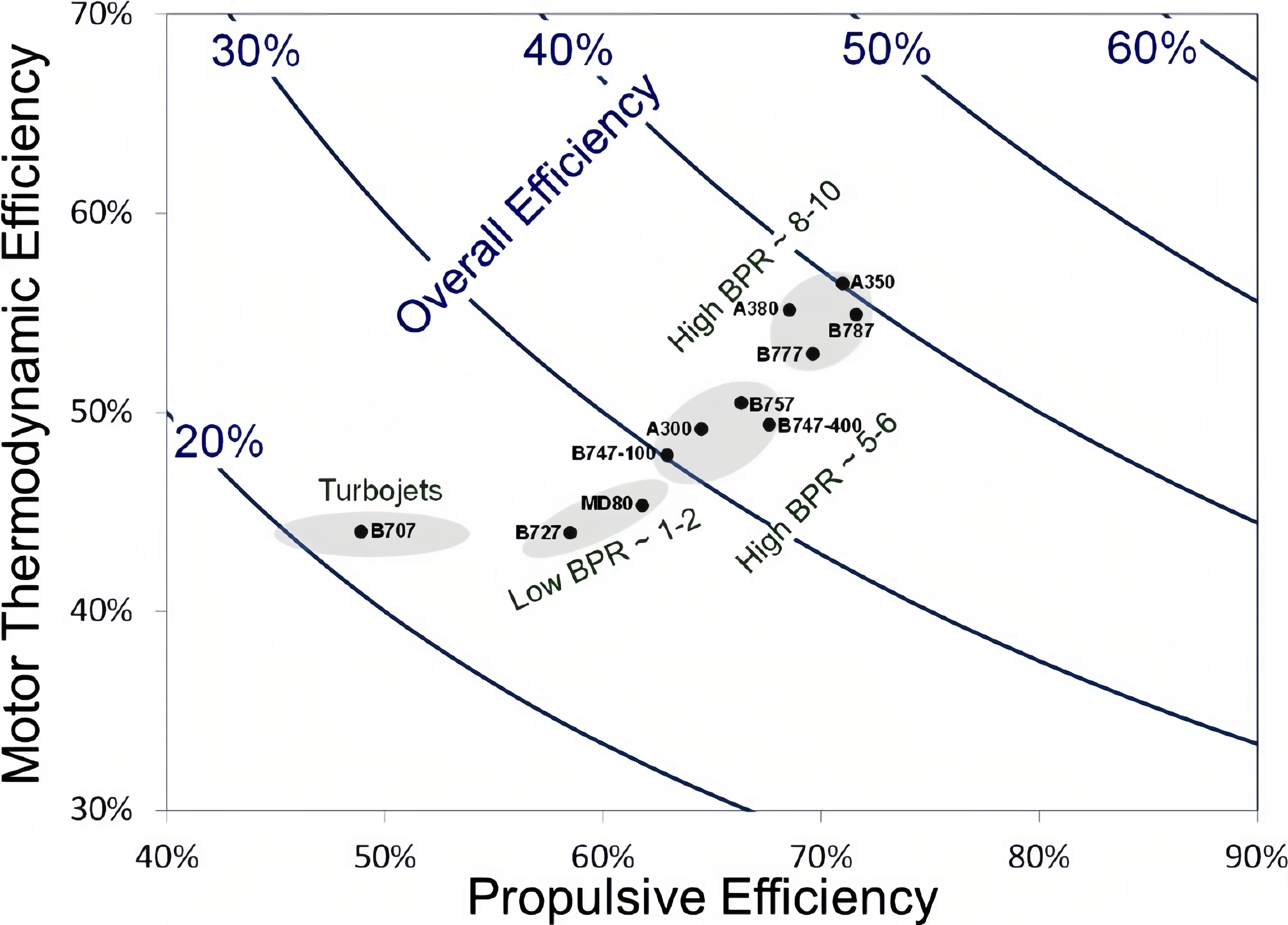
Figure 5. The tendency of engine effectiveness of commercial aircraft. BPR: bypass ratio [8].
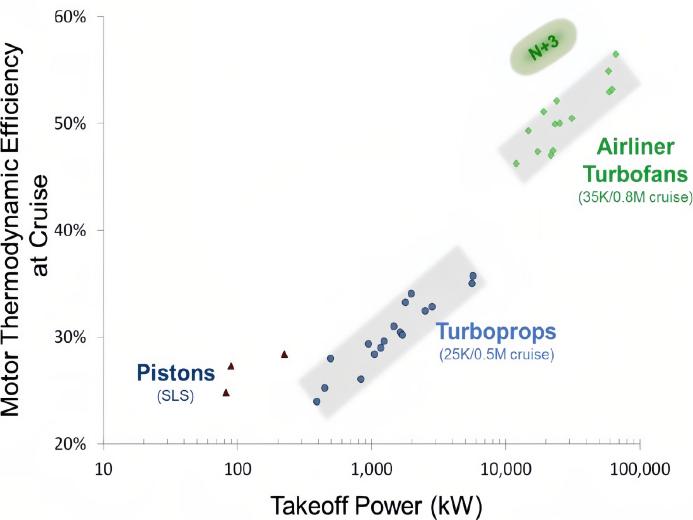
Figure 6. Change of thermal efficiency with the size of engines for airliner turbine engines. SLS: sea level static [8].
Gas turbine engines have a significant margin for further advancement, with overall efficiency gains of 30% or more compared with the current best engines. Improvement will form many small relevant portions but not a single breakthrough of technology [9].
3.2. Materials and manufacturing
The system takes advantage of new materials. They result from reduced weight, a better capacity for bearing high temperatures, or reduced cooling, increasing efficiency. At present, special alloys and advanced air cooling systems are employed. Engine engines also use new materials like ceramic matrix composites and silicon carbide matrix with silicon-carbide fibers.
GEnx (General Electric Next-generation), used on Boeing 787, revolutionizes the materials applied to the engine. The turbine made use of new materials science breakthroughs, being the first commercial engine to apply a new kind of alloy, gamma titanium aluminum, which mixes the capacity of heat resistance of titanium and the light weight of aluminum, taking the place of nickel alloys previously used. But the period of applying these new materials is quite long. Taking these materials from the lab to commercial use took three decades. And Boeing 787 was the first plane to use it, paving the way for materials acceptance in the industry.
Accordingly, the development trend of high bypass ratio turbofan engines directly contributes to the bigger diameter of fan casings. For instance, the previous fan cases CF6-80C2 with a bypass ratio of 5.3, is estimated at a weight ratio of around 20% of the total engine weight, while currently, GEnx-1B, with a bypass ratio of 9.5, is estimated for 33% [10]. Applying polymer matrix composites (PMCs) allows for a decrease in the weight of fan casing in current engines with a high bypass ratio. GEnx engines applied on Boeing 787 are the first jet engines to feature composite front fan covers, saving 350 pounds per engine. The manufacture of the fan case of the GEnx engine involves the application of a triaxial carbon fiber braid as reinforcement material, allowing for a low-cost, repeatable manufacturing process.
While material applications in commercial aircraft engines may justify costs of hundreds or even thousands of dollars per kilogram, the cost-effectiveness of large-scale material applications remains a serious question that needs to be carefully validated. In the 1980s and 1990s, the United States invested much money in composite metal materials, which made a certain breakthrough in engine manufacturing, and carried out several relatively successful material application experiments. However, when these new materials are applied on a large scale, these parts are still too expensive to achieve considerable mass production [9].
3.3. Environmental issue
With the increasing severity of the greenhouse effect, the issue of greenhouse gas emissions from commercial jetliners has gradually been paid more attention to. Nowadays, commercial jetliners are responsible for 5.7% of annual greenhouse gas emissions. The following data will effectively help analyze the current situation of airliner engine greenhouse gas emissions. The relevant indicators for Boeing 747-400 that is used for long-distance travel are shown [11]:
• Distance: 5556 kilometers
• Fuel used: 59.6 tones
• Seats: 416
• Seat occupancy: 80%
• Fuel use: 32.2 grams (passenger kilometer)-1
• Emissions of CO2: 101 grams (passenger kilometer)-1
• Speed: 910 kilometers (hour)-1
Even though it represents only 5.7% of total greenhouse gas emissions, the per capita share is still terrible. Moreover, this CO2 is emitted at the upper altitude, which is likely to produce a more serious greenhouse effect than the CO2 released at low altitudes. Airplanes are believed to have more significant climate effects than emissions of CO2 from fuel combustion. Supplementary effects include the contributions of nitrous oxides and ozone. It is therefore expected that aviation CO2 emissions will rise by a suitable factor, usually considered 2.7. In order to decrease the emission of greenhouse gas, new aviation fuel is likely to be used in the future. H2 is one of the sustainable aviation fuels. It is abundant, clean and will not produce any carbon emission. However, current methods of producing hydrogen are still hampered by expensive costs, and NOx emissions still cannot be dealt with.
4. Conclusion
To recap, various factors affect the performance of jet engines applied on jetliners. In order to gain better performance for a jet engine in the future, factors, namely materials and types of aviation fuel, need to be considered. Accordingly, the cost-benefits should be taken into consideration as well.
On the other hand, the general structure of an airliner has not changed much in the decades since the first gas turbine engine aircraft came out. The current mainstream engine layout is the lower single-wing, wing-hung layout. In civil aviation, this wing-hung layout was first applied to Boeing 367-80 in 1954. this Boeing's self-funded venture would be the basis for Boeing 707, which would come out in 1957. Being developed for nearly 70 years, the wing-hung layout became mature and reliable. Nevertheless, the layout's potential has been tapped, making it more difficult to improve the original architecture substantially.
Changing the type of wing-body layout can be seen as an effective means. A blended wing body is a good example. However, commercial aircraft's blended wing body layout is still in the theoretical stage. Such a novel design concept means designing a brand-new aircraft related to a completely new and sophisticated fly-by-wire control system. Meanwhile, whether the blended wing-body layout has lower maintenance costs and better economic effects has not been verified. In this case, the improvement of the engine performance of commercial aircraft is still particularly vital. This paper only discusses several of the factors. The mountain of factors is still waiting to be considered and coped with.
References
[1]. Sforza P 2014 Commercial Airplane Design Principles 4 81
[2]. Sakhaee E and Jamalipour A 2006 IEEE Journal on Selected Areas in Communications 24 1748
[3]. Van C 2002 Progress in Aerospace Sciences 38 101
[4]. Coplin J 1979 Aircraft Engineering and Aerospace Technology 51 8
[5]. Velupillai D 1980 RB.211-535: Rolls-Royce's Boeing 757 fan 123
[6]. Zaidan M, Relan R, Mills A and Harrison R 2015 Expert Systems with Applications 42 8472
[7]. Gudmundsson S 2022 General Aviation Aircraft Design (Second Edition) 14 573
[8]. Epstein A 2014 AIAA Journal 52 901
[9]. O’Connell A, Kousoulidou M, Lonza L and Weindorf W 2019 Renewable and Sustainable Energy Reviews 101 504
[10]. Njugna J 2016 Lightweight Composite Structures in Transport 12 305
[11]. Wood F, Bows A and Anderson K 2010 Transport Policy 17 206
Cite this article
Li,S. (2023). Development trends and future expectations of jet engine. Applied and Computational Engineering,11,129-136.
Data availability
The datasets used and/or analyzed during the current study will be available from the authors upon reasonable request.
Disclaimer/Publisher's Note
The statements, opinions and data contained in all publications are solely those of the individual author(s) and contributor(s) and not of EWA Publishing and/or the editor(s). EWA Publishing and/or the editor(s) disclaim responsibility for any injury to people or property resulting from any ideas, methods, instructions or products referred to in the content.
About volume
Volume title: Proceedings of the 2023 International Conference on Mechatronics and Smart Systems
© 2024 by the author(s). Licensee EWA Publishing, Oxford, UK. This article is an open access article distributed under the terms and
conditions of the Creative Commons Attribution (CC BY) license. Authors who
publish this series agree to the following terms:
1. Authors retain copyright and grant the series right of first publication with the work simultaneously licensed under a Creative Commons
Attribution License that allows others to share the work with an acknowledgment of the work's authorship and initial publication in this
series.
2. Authors are able to enter into separate, additional contractual arrangements for the non-exclusive distribution of the series's published
version of the work (e.g., post it to an institutional repository or publish it in a book), with an acknowledgment of its initial
publication in this series.
3. Authors are permitted and encouraged to post their work online (e.g., in institutional repositories or on their website) prior to and
during the submission process, as it can lead to productive exchanges, as well as earlier and greater citation of published work (See
Open access policy for details).
References
[1]. Sforza P 2014 Commercial Airplane Design Principles 4 81
[2]. Sakhaee E and Jamalipour A 2006 IEEE Journal on Selected Areas in Communications 24 1748
[3]. Van C 2002 Progress in Aerospace Sciences 38 101
[4]. Coplin J 1979 Aircraft Engineering and Aerospace Technology 51 8
[5]. Velupillai D 1980 RB.211-535: Rolls-Royce's Boeing 757 fan 123
[6]. Zaidan M, Relan R, Mills A and Harrison R 2015 Expert Systems with Applications 42 8472
[7]. Gudmundsson S 2022 General Aviation Aircraft Design (Second Edition) 14 573
[8]. Epstein A 2014 AIAA Journal 52 901
[9]. O’Connell A, Kousoulidou M, Lonza L and Weindorf W 2019 Renewable and Sustainable Energy Reviews 101 504
[10]. Njugna J 2016 Lightweight Composite Structures in Transport 12 305
[11]. Wood F, Bows A and Anderson K 2010 Transport Policy 17 206





